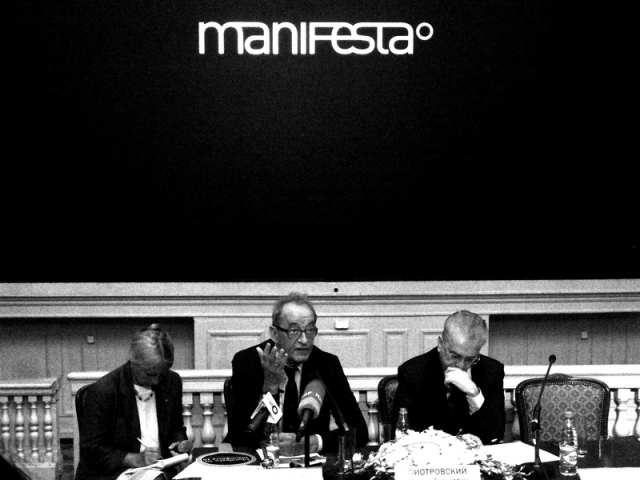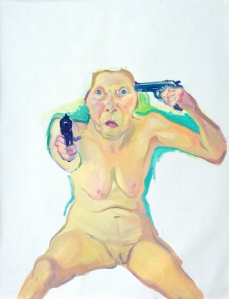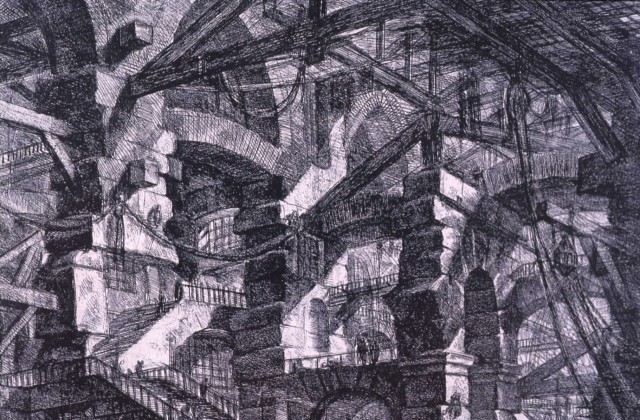So, we know we’ve been covering a lot about Manifesta recently, but it’s on our minds (and we would certainly rather cover this than cover the highjinks with the Museum of Authority – most recently that a purported member of Voina pulled a stunt there, that, frankly, we hope doesn’t get picked up to the extent the last episode at the same museum did.)
More specifically, questions over a boycott of Manifesta prompted the biennial to make a strong stand for the political power of art, literally: on August 30, 2012, the foundation released a statement entitled “To Withdraw Manifesta 10 would mean to ignore contemporary voices and emerging generations of Russia.” This text maintains that “on principle Manifesta cannot and should not only perform in the ‘safe haven’ of the West or former West.”
What is clear is that progressive, contemporary culture in Russia is contested and, as ideas continue to be exchanged across borders, we believe it is vital to play an active role in this dialogue. Manifesta was initiated as a discursive, adaptable artistic entity in response to the new social, cultural and political realities that emerged in the aftermath of the Cold War. Manifesta 10 will investigate these 25 years of changing realities and experiences as they have transformed within this new global world order.
Find the full statement here.
So far, this would all seem to be in keeping with the spirit of Manifesta, described on their website:
Manifesta purposely strives to keep its distance from what are often seen as the dominant centres of artistic production, instead seeking fresh and fertile terrain for the mapping of a new cultural topography. This includes innovations in curatorial practices, exhibition models and education. Each Manifesta biennial aims to investigate and reflect on emerging developments in contemporary art, set within a European context. In doing so, we present local, national and international audiences with new aspects and forms of artistic expression.
In other words, Manifesta arrived as a fresh injection into an increasingly institutionalized art scene. It acted against monopolies on representation, directing attention towards marginalized locales and populations. Sometimes this tactic worked, as in the lyrical Manifesta 9, sited in a former mine in Belgium. Sometimes it did not work, such as in the case of Manifesta 6, which sought to suture the political rifts in Cyprus, only to fall apart at its own seams.
If the announcement that Manifesta 10 would take place in the Hermitage – one of the world’s biggest museums – raised a few eyebrows, the following announcement that the esteemed and accomplished Kasper Koenig would serve as curator prompted more than one debate about what happened to the focus on the emerging or the marginalized. The political backlash and calls for boycotts opened a window, allowing Manifesta to make the stand it made in those August 30 statements, reinforcing its commitment to forging and fostering political discussions. After all, in certain environments (see above, Cyprus), the otherwise bland commitment to a “neutral space for discussion” can actually be quite political.
We of all people understand the complexities and unfortunate political maneuverings often required when working in Russia, a country where the commitment to the arts comes with a pricetag – well, rather, several price-tags, at every step of the process. We recognize that Manifesta is working on a very short timeline (it is slated to open June 28, 2014), would not want to jeopardize the work it has done so far in securing this prestigious venue and this prestigious curator. But at a certain point the question is, does Manifesta need prestige?
On Friday, September 5, 2013, Koenig and Manifesta director Hedwig Fijen traveled to St Petersburg to deliver a press conference at the Hermitage. Granted, we recognize that the aim of this event may have been to appease local authorities, but we were still somewhat disappointed in the outcome. The best report of the proceedings so far was written by Pavel Gerasimenko, which you can find here.
Titled “Since St Petersburg Regained Its Name,” the exhibition will be split as a dialogue between the main Winter Palace of the Hermitage and its recently-opened General Staff building. According to Manifesta, 15 of the 43 invited artists have already agreed to participate. Gerasimenko lists the international stars Jeremy Deller, Marlene Dumas, Maria Lassnig and Louise Bourgeois (whose works Koenig plans to juxtapose alongside the Hermitage’s suite of Piranesi architectural drawings), but then expresses the regret that the Russian list shows little imagination. Or rather, it shows imagination – all of the artists are working in a decidedly whimsical tone – but these are also familiar international-approved artists: Ilya Kabakov and Pavel Pepperstein (both on view in the current Bergen Assembly – [[NB: Artguide’s report makes no mention of these two artists as confirmed]) and then New Academy heros Timur Novikov and Vlad Mamyshev-Monroe. This combination at first reads as disappointingly safe, but the specific combination does give us hope – but we’ll get to that later.
So, on the topic of hope, in response to a question about the exhibition concept, Gerasimenko quotes Koenig as roughly saying the following:
I hope that the biennale will be easily accessible to all who would like to see it, that it can be produced on a smaller budget, and without visa complications. I hope that it will make a difference for young people, and give those young people even more reason to feel proud of their city, a city that is looking towards the future. It is a great honor for me to have the opportunity to work in the museum, a place where one is always confronted with aesthetic ideas. We have much to show this interested public. It is important that every person has a chance to understand our position and decide for his or herself what is important. I was born at the end of 1943. I grew up during the dramatic era of Nazism. I am now an old man, who has also followed his politic instinct, but never in any case the ideological. This allows me to be precise, though not comfortable.
Koenig’s main obstacle, as Gerasimenko deduces, is not the recent discriminatory laws (laws which might pale to those witnessed in the curator’s childhood), but rather in Russia’s “phobia of all things contemporary, whether that’s aesthetic or representations of gender” (Gerasimenko’s words, not Koenig’s). Artists are still marginalized into a type of “ghetto,” with a limited audience. That the “traveling circus of contemporary art” is sited in the Winter Palace lends it a credibility, despite the fact that previous projects of Hermitage 20/21 (the contemporary initiative, led by Dmitry Ozerkov) have resulted in what Gerasimenko calls “cognitive dissonance” (The Chapman Brothers exhibition was not, in any sense of the word, a grand success.) Gerasimenko finishes: “After the press conference of Kasper Koenig, it’s safe to make two assumptions. The first is that Manifesta is definitely happening. The second is that in all probability, what awaits us is an extremely sophisticated and considered museum exhibition.”
So, while this skirted any overt political commentary, we have some hope that the Timur and Monroe –both artists whose works skirt the lines (or in some instances line the skirts) of homosexual propoganda – combined with icons like Bourgeois and Lassnig might signal that Koenig is taking a more sophisticated approach to questions of gender, one that might be able to glide through the Winter Palace with more subtlety than the recent portraits of Putin in panties.
As an update, this morning Anna Matveeva published a post-press-conference interview with Koenig in which he expounds more about the selection of the city, how his biennial will be about “history, not nostalgia,” and how the Hermitage itself will play the starring role. You can find this interview here, in Russian.




Pingback: A Call for Proposals to Reimagine Russia’s National Center for Contemporary Art | Baibakov Art Projects
Pingback: ГЦСИ приглашает разработать дизайн музейно-выставочного комплекса | Baibakov Art Projects
Pingback: A Tale of Two Biennales: Istanbul and Moscow | Baibakov Art Projects
Pingback: О двух биеннале. Москва и Стамбул. | Baibakov Art Projects
Pingback: Manifesta receives nearly triple the state funding as the Moscow Biennale | Baibakov Art Projects
Pingback: Манифеста получит от государства сумму в три раза больше, чем Московска биеналле | Baibakov Art Projects
Pingback: Манифеста получит от государства сумму в три раза больше, чем Московская биеналле | Baibakov Art Projects
Pingback: Манифеста получит от государства сумму в три раза больше, чем Московская биеннале | Baibakov Art Projects
Pingback: 1444: Med hybriden som tröst at Vilks.net
Pingback: Let’s Change It All: Sydney Biennale’s parting with Transfield gives hope to Manifesta protests | Baibakov Art Projects
Pingback: Давайте Измененим Все Это: Сиднейская биеннале рассталась с Transfield | Baibakov Art Projects
Pingback: From Matisse to Alys in Manifesta 10, while Moscow contemplates an Absolute Wine Factory | Baibakov Art Projects
Pingback: Love Stories: Margarita Tupitsyn curates the Russian Pavilion, while much ado in Baku and London | Baibakov Art Projects